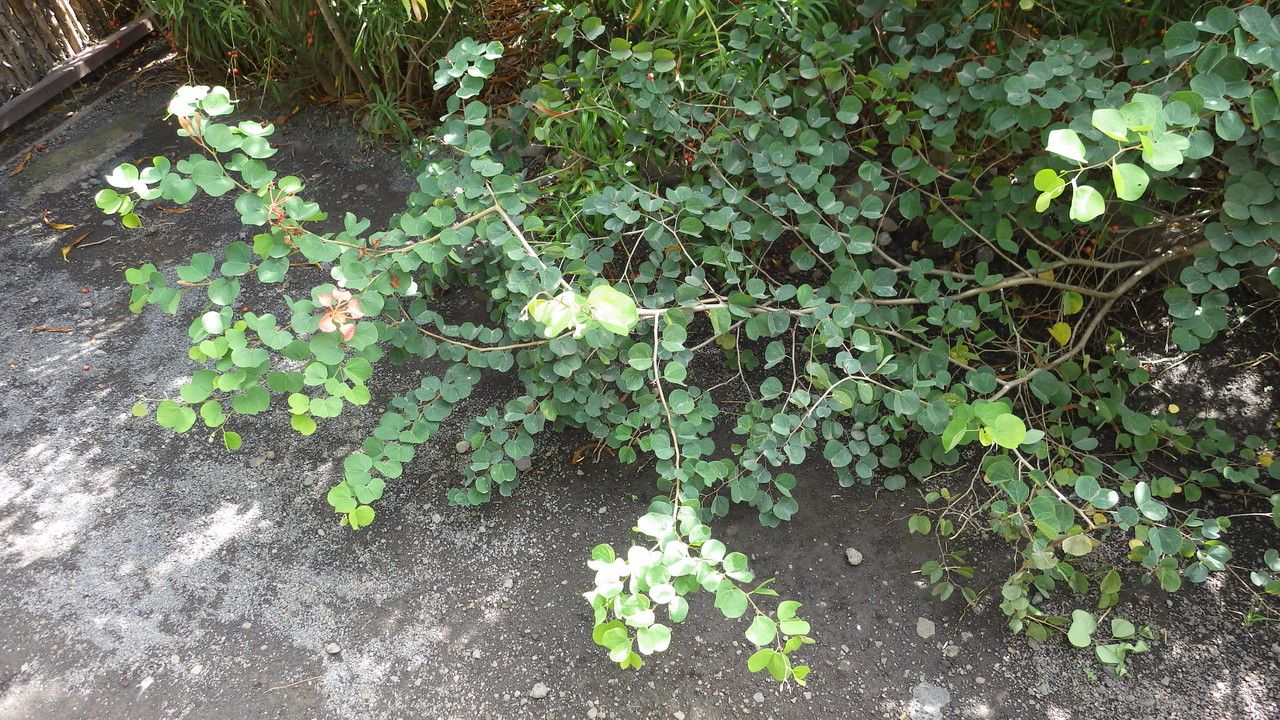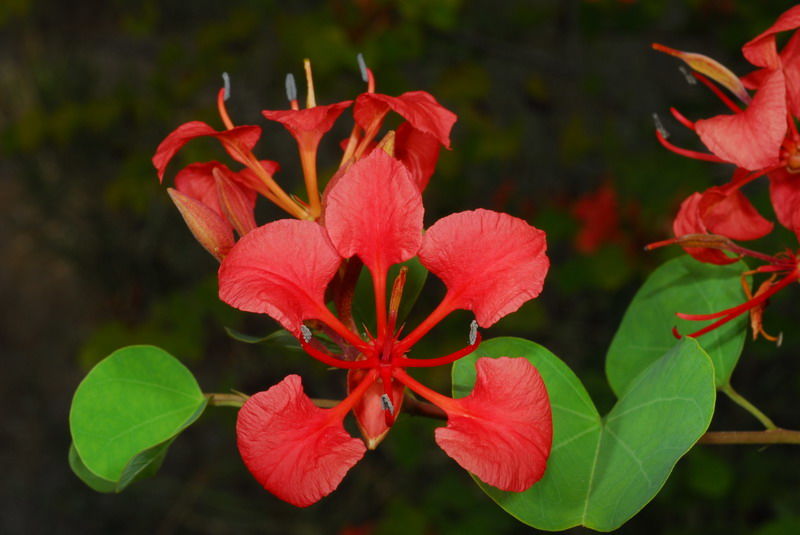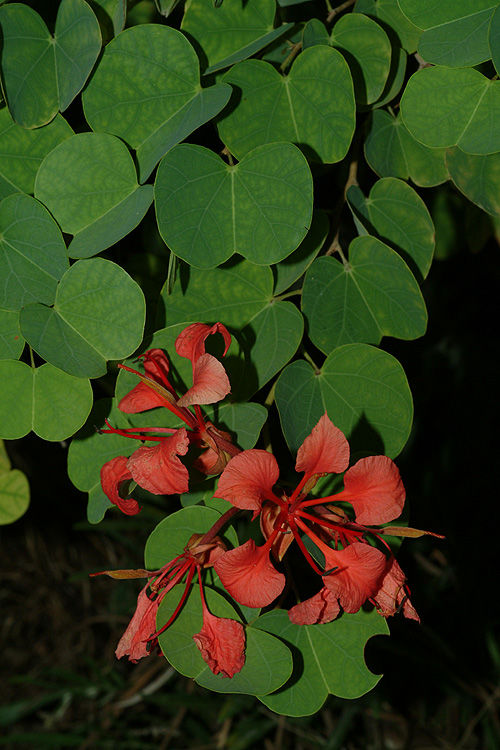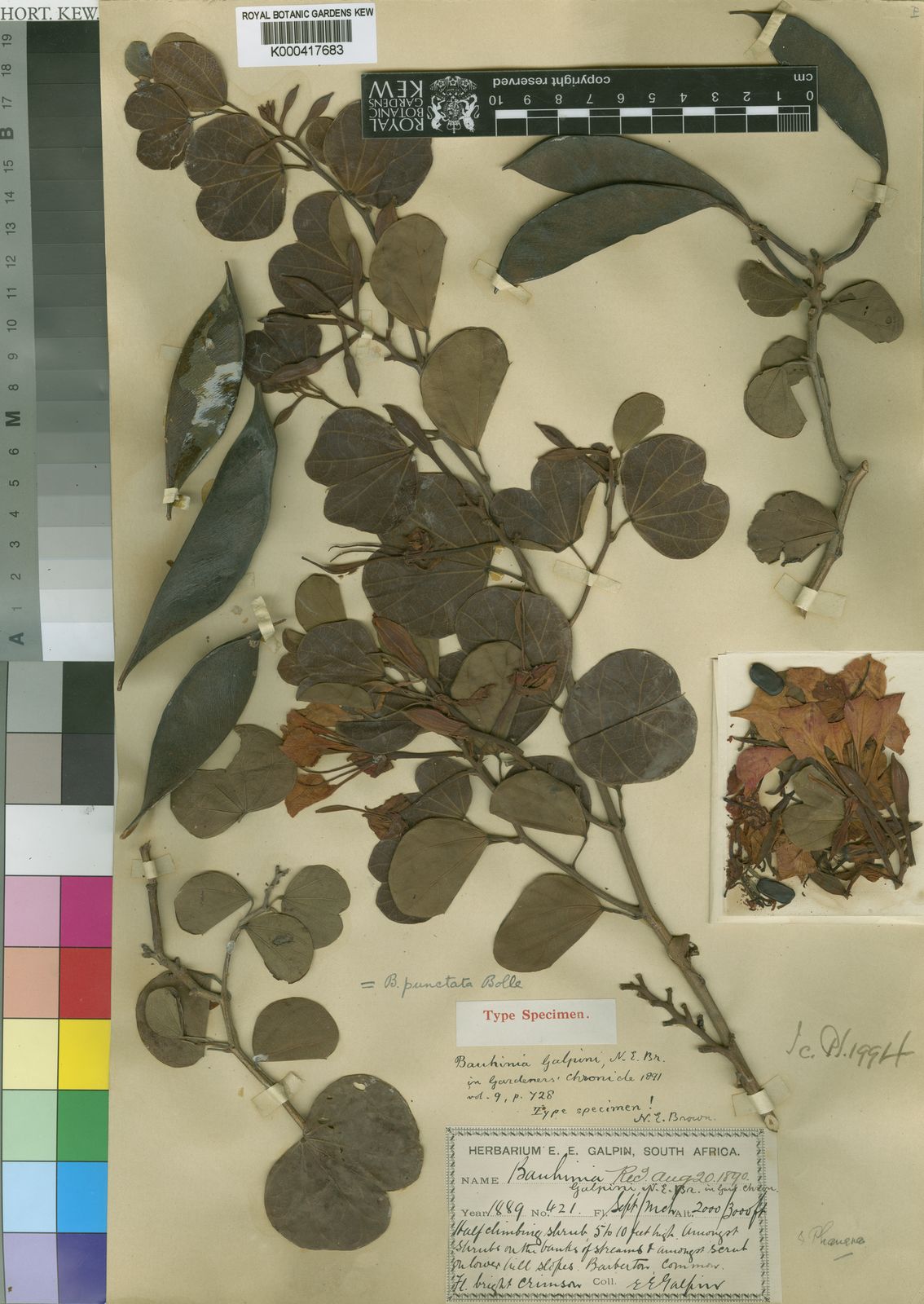Red Bauhinia, Pride of Roodepoort
bauhinia galpinii
Also known as: ["Pride of Roodepoort","Red Orchid Tree"]
Overview
A deciduous shrub or small tree native to southern Africa, known for its vibrant red-orange flowers that resemble orchids.
Benefits & Perks
["long-flowering","fragrant flowers","wildlife attractant (bees, butterflies, birds)","drought tolerant","aesthetic foliage"]
Botanical Classification
| Phylum: | Magnoliophyta |
| Class: | Magnoliopsida |
| Order: | Fabales |
| Family: | Fabaceae |
| Genus: | Bauhinia |
| Botanical Name: | Bauhinia galpinii |
Plant Characteristics
Basic Information
- Category: Flowers
- Suitable Location: outdoor garden bed in warm, sunny areas
- Suitable For:
- Is Weed: No
- Allergenicity: low
Environmental Needs
- Climate: {"temperatureRange":"5–35°C"}
- Hardiness: {"zones":"9–11"}
- Misting: rarely required, only if grown in very dry indoor conditions
- Drainage: Fast-draining to prevent waterlogging.
- Soil Type: Well-draining, sandy loam with organic matter. Cactus or succulent mix is ideal.
Maintenance Level
- Maintenance Level: moderate
- Toughness Level: high
- Pruning Frequency: Annually, after flowering or in late winter/early spring.
- Pruning Intensity: Moderate. Remove up to one-third of old growth if needed.
Care Details
Ideal Sunlight Coverage:
Full sun (6–8 hours of direct sunlight daily). Tolerates partial shade but may flower less.
Sunlight Tolerance Tips:
Acclimate new plants to full sun gradually over 1–2 weeks. Protect from intense midday sun in hot climates to prevent leaf scorch. Outdoor placement is ideal for maximum flowering.
Care Requirements
Care Difficulty
moderatemoderate
Sunlight
full sun
Full sun is best; acclimate new plants; protect from harsh midday sun.
Watering
every 7–14 days during active growth, reduce in winter
Water thoroughly but infrequently; ensure soil dries slightly between waterings; avoid overwatering, especially in winter.
Soil
well-drained, sandy loam with moderate organic content
pH: Slightly acidic to neutral (pH 6.0–7.0).
Ensure excellent drainage; amend with sand or perlite; avoid heavy clay soils.
Temperature
Thrives in warm conditions (65–85°F or 18–29°C). Tolerates brief dips to 25°F (-4°C) but prefers frost-free environments.
Protect from frost; ensure good air circulation in heat; adjust watering for temperature swings.
Fertilizing
every 4–6 weeks during spring and summer
Fertilize in spring before new growth; use balanced formula; reduce in winter.
Propagation
Methods
Stem cuttings or seed. Stem cuttings are more reliable for home growers.
Step-by-Step Propagation Guide
- Take 4–6 inch cuttings.
- Remove lower leaves.
- Dip in rooting hormone.
- Plant in medium.
- Keep moist and warm.
Best Time: Late spring to early summer when the plant is actively growing.
Environment
Warm (70–75°F or 21–24°C), humid, and bright but indirect light.
Medium
Well-draining mix of perlite and peat moss or cactus mix.
Hormone
Recommended to use rooting hormone for faster and more reliable rooting.
Timeline
Roots typically form in 4–8 weeks; new growth may take 2–3 months.
Tools Needed
Pruning shears, rooting hormone, small pots, well-draining medium.
Quick Tips
Use healthy, non-flowering stems; keep consistently moist; provide bottom heat if possible.
Pruning & Repotting
Pruning Guide
Method
Selective thinning and heading back to maintain shape and promote airflow.
Pruning Plan
Prune to shape the plant, encourage bushier growth, and remove dead or diseased wood. Prune after flowering to avoid cutting off buds.
Tools
Pruning shears, loppers (for larger branches), gloves.
Checklist
Disinfect tools; prune after flowering; remove dead/diseased wood; shape as desired.
Repotting Guide
Best Season
Early spring, before the active growth period begins.
Pot Size
One size larger pot (e.g., +2 inches in diameter).
Method
Remove plant gently; trim any circling roots; place in a slightly larger pot with fresh, well-draining soil; water thoroughly after repotting.
Suggestions
Repot only when root-bound or every 2–3 years. Over-potting can lead to root rot.
Checklist
Choose appropriate pot size; use fresh soil; trim roots if needed; water after repotting.
Advanced Care Tips
Watering Mastery
Watering Checklist
Check soil moisture before watering; water deeply; ensure drainage; adjust for season.
How to Apply Water Properly
Water at the base of the plant, ensuring moisture reaches the root zone. Water early in the morning to minimize evaporation and allow foliage to dry. Ensure excess water drains away to prevent root rot.
Watering Schedule Tips
Water deeply once a week during active growth; reduce frequency to every 2–3 weeks in winter. Adjust based on rainfall and soil moisture.
Soil Improvement
Add perlite, coarse sand, or compost to improve drainage and aeration. Ensure organic matter is well-decomposed.
Temperature Stress Management
Signs of Temperature Issues
Chlorosis or leaf drop in cold stress; wilting or scorching in excessive heat.
Cold Stress
Growth slows or halts; leaves may turn yellow or drop; prolonged cold can damage stems and roots.
Solution: Mulch heavily to insulate roots; move potted plants indoors or to a sheltered location; avoid watering during cold snaps.
Hot Stress
Leaves may wilt, scorch, or drop; flowering may be reduced; soil dries out quickly.
Solution: Provide afternoon shade in extreme heat; water deeply and mulch to retain moisture; increase humidity if grown indoors.
Fertilizing Guide
Fertilizing Checklist
Use balanced fertilizer; apply in spring; dilute liquid feeds; avoid winter feeding.
Fertilizing Method
Use a balanced, slow-release fertilizer in early spring. Apply a diluted liquid fertilizer monthly during active growth (spring to summer). Avoid fertilizing in fall and winter.
Common Problems & Solutions
Toxicity Warning
Cats
Slightly ToxicCats may experience mild gastrointestinal irritation if they consume Bauhinia galpinii seeds or pods. The toxic compounds in these parts can cause digestive disturbances, though severe reactions are rare.
⚠️ Symptoms:
🌿 Toxic Parts:
⚡ Toxic If:
if eaten
Dogs
Slightly ToxicIn dogs, ingestion of Bauhinia galpinii seeds and pods can lead to mild gastrointestinal upset due to the presence of lectins and other irritants. The effects are generally not life-threatening but can cause discomfort.
⚠️ Symptoms:
🌿 Toxic Parts:
⚡ Toxic If:
if eaten
Humans
Slightly ToxicBauhinia galpinii contains compounds that can cause mild gastrointestinal distress when ingested. The toxicity is primarily localized to the seeds and pods, which may contain lectins and other bioactive substances that disrupt normal digestive processes.
⚠️ Symptoms:
🌿 Toxic Parts:
⚡ Toxic If:
if eaten
Frequently Asked Questions
Q: How often should Bauhinia galpinii be watered?
A: Water moderately during the growing season, allowing the soil to dry slightly between waterings. Reduce watering in winter.
Q: Does Bauhinia galpinii attract wildlife?
A: Yes, it is highly attractive to bees, butterflies, and birds due to its nectar-rich flowers.
Q: Is Bauhinia galpinii suitable for drought-prone areas?
A: Yes, it is drought-tolerant once established and thrives in arid conditions.
Quick Reference
| Family: | Fabaceae |
| Care: | moderate |
| Light: | full sun |
| Water: | every 7–14 days during activ |
Get Expert Care Tips
Download the Plantious app for personalized care reminders and plant identification!
Google Play App Store








